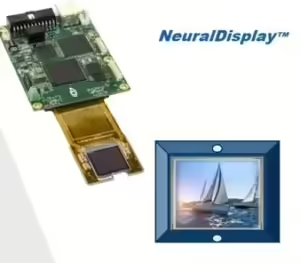Kopin’s NeuralDisplay is a 1.5-inch square micro-OLED with a resolution of 3,840 x 3,840 pixels and a maximum brightness of 10,000 candelas. It featured an unusual quad-pixel arrangement with red, blue, and green sub-pixels alongside a fourth pixel containing a pixel imager. This pixel imager is not a display element but measures the light reflected by the user’s eyes. Operating in monochrome, it focuses on measuring brightness to deduce details about a user’s eyes, such as the direction of their gaze, their eye position in relation to the screen, and pupil dilation.

The data from the pixel imagers feed into an AI model that compensates for each user’s vision quirks by adjusting the display’s brightness and contrast in real-time. The pixel imagers continually take readings, creating a feedback loop that ensures the display adjustments align with the user’s visual experience.
NeuralDisplay incorporates integrated eye tracking, eliminating the need for separate eye-tracking cameras, which makes AR/VR headsets lighter and more compact. The data captured by the image-sensing pixels is processed by an onboard AI accelerator, ensuring low latency and real-time adjustments to match the speed of human visual processing.
Up until recently, that was all theory but now the technology has reached the Alpha testing stage, a critical phase where the core functionalities are tested in a controlled environment. This stage involves testing integrated eye-tracking algorithms, dynamic display adjustments, and the performance of the onboard AI processor. Feedback from internal testers is used to identify and fix bugs, usability issues, and performance bottlenecks. The Alpha stage also serves as a proof of concept, demonstrating that NeuralDisplay can achieve its intended goals, such as high-fidelity eye tracking, dynamic display adjustments, and real-time neurological response analysis.
Kopin has created demonstration videos to showcase NeuralDisplay’s capabilities, such as the one below showing a user controlling a spaceship with their eye movements. The Alpha testing stage marks a pivotal point in the development of NeuralDisplay, paving the way for further refinement and eventual commercial release.

